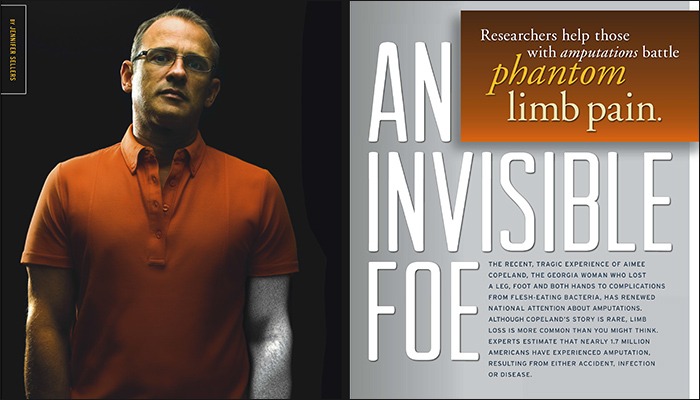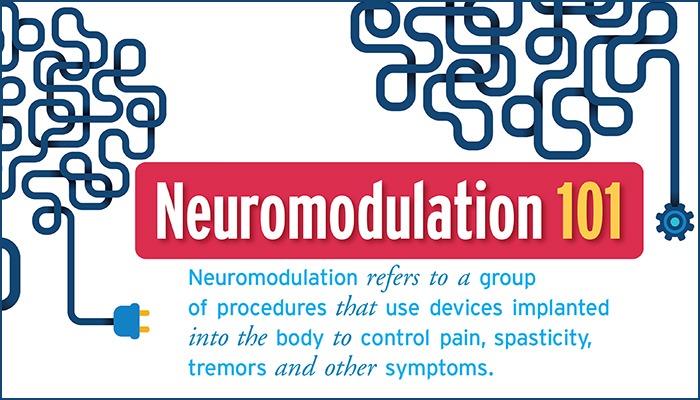Phantom Limb Pain

Journalist Michael Weisskopf was on assignment in Baghdad for Time magazine’s 2003 “Person of the Year”—the American soldier—when a tragic accident severed his right hand. He still recalls in surreal detail the moment he saw a grenade on the floor of the Humvee he was in—and his attempt to toss it out.
Something in me clicked and made me lunge for it,” he says. “It was so hot I could feel my hand burning—an intense pulsating, burning, squeezing sensation. I remember the arching movement of my arm as I tried to heave it over the side of the Humvee … but then I blacked out. I woke up seconds later only to discover that my wrist looked like the neck of a decapitated chicken.”
It’s been nine years since this traumatic, life-altering event. Weisskopf has healed and moved on in many ways, including writing Blood Brothers: Among The Soldiers Of Ward 57, an account of his stay at Walter Reed Medical Center, but phantom limb pain is an ever-present reminder of his injury.
Most people who have experienced loss of limb suffer from phantom limb pain, says Steven P. Cohen, MD, director of chronic pain research at Walter Reed Medical Center and professor of anesthesiology at the Uniformed Services University of the Health Sciences.
“The most cited statistics [concerning incidence of] phantom limb pain after any amputation are around 60 percent to 80 percent,” says Dr. Cohen. “But when you talk about phantom limb pain after the amputation of a major limb, it’s almost universal.”
HIDDEN CAUSES
Phantom limb pain—a sensation of pain where a limb used to be—may sound like a figment of the imagination, but it’s very real. The causes, however, are difficult to pinpoint.
“Phantom limb pain is a syndrome, not a disease,” explains Dr. Cohen. “That means there can be many different mechanisms behind the pain. The cuases can be central, spinal or peripheral. In other words, the pain can originate in the brain, the spinal cord or the residual limb.”
Central and spinal phantom limb pain are believed to happen because the brain still has a representation of the missing limb. That is, the central and spinal wiring that once processed signals to and from the missing limb still exists. When the limb is lost, those brain and spinal cord circuits do not simply shut off—they have to reorganize. This process may explain why some people born without a limb don’t develop phantom limb pain: they may never have had a central representation of the limb.
Peripheral causes are not due to reorganization of pain signals. Rather, the pain extends from residual nerves in the stump that were cut during the amputation.
In addition, Dr. Cohen says many patients report peripheral pain referred from elsewhere in the body. For instance, some people report symptoms of sciatica in a missing leg or shingles pain in a missing arm.
At times it is difficult to single out the source of the pain. “We have to help the patient distinguish between phantom limb pain and phantom sensations, like feelings of tingling or hot and cold,” Dr. Cohen says. “Complicating matters is the frequency of overlap in the different sensation and pain mechanisms.”
People with amputations often also have secondary pain issues to manage. Back pain, hip pain and bursitis are common complications of leg amputations. In addition, patients who wear prosthetic limbs can experience prosthesis-related pain.
Weisskopf says he has experienced nonstop pain since the moment the grenade took his hand. After a period of incessant post-surgical pain, he began to develop stump pain, which he describes as feeling like a bad bone bruise. His goal now is to find relief—anything that will reduce his chronic pain. “Pain is an ever-present part of my world,” says Weisskopf. “It’s something I’ve learned to live with.
Dr. Cohen says Weisskopf’s situation is not unique. “Not only do phantom limb pain and residual limb pain tend to develop rapidly, they also are likely to be more severe in people who have experienced traumatic amputations, such as those that occur with war injuries,” he says.
TREATMENT CHALLENGES
Phantom limb pain’s stubborn resistance to treatment is widespread amon amputees. According to Dr. Cohen, this is because it’s difficult to home in on a clear-cut cause.
“If the pain is coming from the stump itself, or if it’s coming from somewhere like a herniated disc, you might get lucky and address the cause,” he says.
Even when the cause is determined, treatment can still be challenging. For instance, central-mechanism phantom limb pain is notoriously difficult to treat. “In these instances, sometimes you have to wait for the brain to adjust itself, and just treat the pain as well as you can until then,” says Dr. Cohen.
Currently, first-line treatments for phantom limb pain include anticonvulsants and tricyclic antidepressants. However, these medications are only minimally effective for a large number of patients.
Opioids tend to do a better job at targeting the pain, but are recommended in the short term. “These medications aren’t good for long-term treatment,” says Dr. Cohen. “Over time, patients may develop a tolerance for them.”
Other treatment options include intrathecal drug delivery, spinal cor stimulation, anesthetic of steroid injections, transcutaneous electrical nerve stimulation (TENS) and acupuncture.
Because people with phantom limb pain can also experience depression, anxiety and sleep disorders, other medications and therapies may be prescribed to treat those co-existing conditions.
“We’re looking for a functional, multidisciplinary approach in treating this Pain,” says Dr. Cohen. “Keeping an open mind and a willingness to try different treatments is really important. Often, it’s trial by error.”
Weisskopf says he has tried everything: “In the beginning, I had novocaine-like injections. It was the only thing that ever stopped the pain, but it had diminishing returns after a while. Since then, I’ve had well over a dozen different kinds of pain treatments—Botox injections, acupuncture, electrical stimulation—and none of them treated my pain worth a damn. One thing that has been semi-successful in combination with the other drugs I take has been Elavil [a tricyclic antidepressant]. It knocks out maybe half the pain. Dr. Cohen has been extremely innovative in helping me find the right combination, and I know he has a few more strategies up his sleeve.”
CURRENT RESEARCH
While current treatment options for managing phantom limb pain are limited, Dr. Cohen and many other researchers are working hard to find new solutions. Recent studies have looked at application of epidural catheters to prevent phantom limb pain before it starts and neurotherapeutic mirror box treatments to trick
the brain with visual information. Although results have been mixed, the research is promising. Another study is investigating the use of peripheral nerve catheters with a local anesthetic.“They think this might affect the reorganization in the brain,” says Dr. Cohen.
The Sceptor Pain Foundation will soon begin a large multi-site study examining the possible role of spinal cord stimulators in reducing phantom limb pain. The project will focus on war-wounded veterans with amputations. Sceptor is coordinating with Veterans Affairs’ hospitals, military base hospitals and the U.S.
Department of Defense to monitor approximately 180 subjects over three years.“This is the first time there’s been a large study like this,” says Jason Hong, MD, clinical research coordinator for the project. “This will give us more insight into how patients fare with spinal cord stimulation: if it has a positive long-term effect on their lives or if the benefits decrease over time.”
Sceptor trial participants will be encouraged to remain on a comprehensive treatment plan while participating in the study. “We won’t restrict what patients do,” says Dr. Hong. “Overall, we’re looking at a holistic approach in coordination with the spinal cord stimulators.”
“This is a passion,” says Dr. Hong about Sceptor’s
motivation for the study. “It’s our way of giving back to the military community that’s served us so well and so faithfully over the years.”
NEW HOPE
Current therapies and new research offer various opportunities for people with phantom limb pain. In addition, hope remains that some individuals may find relief over time through the healing process itself. “In some patients, the body adjusts over the yearsand the pain can subside naturally,” says Dr. Cohen.
In the meantime, Weisskopf suggests keeping an open mind when dealing with phantom limb pain. “I would recommend to anyone to try the pain strategies out there,” says Weisskopf. “They wouldn’t be strategies if they didn’t work in some people, so you should keep trying to see if something works for you. Don’t give up; anything you can do to diminish the pain can make for a richer life.” {PP}
PainPathways Magazine
PainPathways is the first, only and ultimate pain magazine. First published in spring 2008, PainPathways is the culmination of the vision of Richard L. Rauck, MD, to provide a shared resource for people living with and caring for others in pain. This quarterly resource not only provides in-depth information on current treatments, therapies and research studies but also connects people who live with pain, both personally and professionally.
View All By PainPathways






